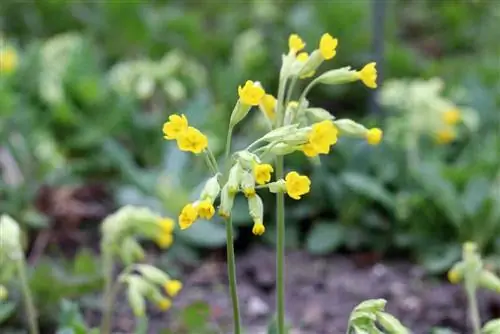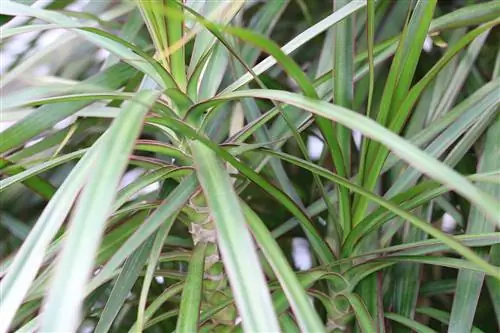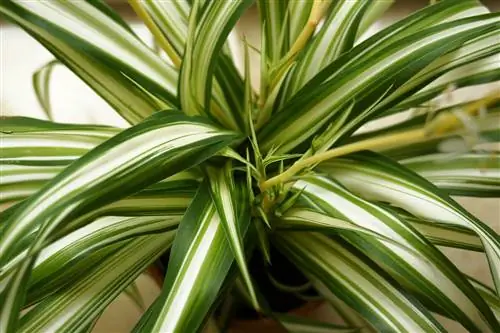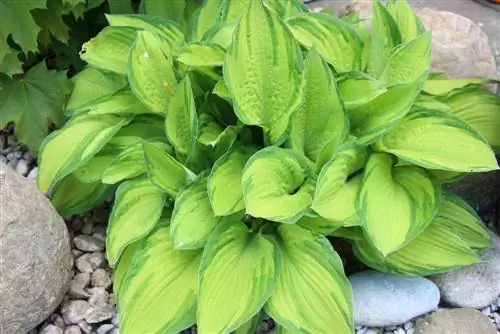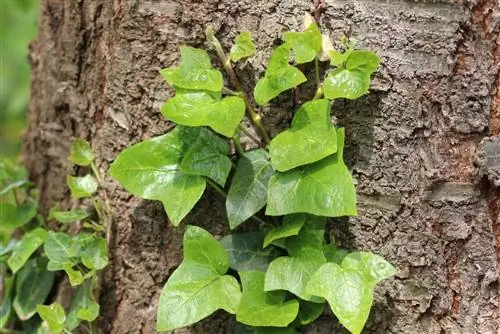- Author admin [email protected].
- Public 2023-12-17 03:39.
- Last modified 2025-01-24 12:45.
The bowl flower contains some ingredients that are not entirely harmless, which is why it may only be used in small quantities. However, it is far more dangerous to confuse them with poisonous relatives.
Ingredients
The native species here is, among others, the meadow primrose (Primula veris). It is protected in some areas and may only be picked in small quantities, if at all. Many people have plants from specialist retailers in their gardens, where their use is of course permitted. Due to its ingredients, it is a traditional medicinal plant, but in high doses it can also be dangerous.
The ingredients of Primula veris:
- Saponins
- Flavonoids
- Essential Oil
- Triterpene saponins
- Sugars
Note:
The content of ingredients varies depending on the part of the plant. The roots in particular contain a large amount of triterpene saponins.
Effect
The triterpene saponins are used in folk medicine to irritate the gastric mucosa, which in turn is supposed to stimulate the bronchial mucosa to produce mucus. The meadow primrose is advertised as a cold remedy for bronchial infections, but is not entirely without side effects.
In particular, irritation of the stomach lining can lead to the following side effects in humans:
- Stomachache
- Nausea
- Diarrhea
- Overstimulation of the mucous membranes
- Dermatitis
In rare cases, vomiting and significant allergic skin reactions can occur. The skin reactions can be seen even if affected people have only used extracts from the plants internally.
Danger to people
For he althy adults, the bowl flower can be safely eaten in small quantities. The herb is used for this purpose and the root of the cowslip is a traditional medicinal plant in folk medicine. However, you should avoid the bowl flower if you have children or small children. For example, coughing up mucus can become problematic without additional help and the stomach can become very irritated.
Use of the cowslip:
- Flowers: edible decoration, dye, tea
- Leaves: cut into small pieces for salads
- Roots: Tea for bronchial problems
Primula veris is only suitable to a limited extent as a coloring plant, because in order to obtain a significant color, large quantities of flowers must be present. However, usually only small quantities are available, enough to dye a few Easter eggs. However, you can use the flowers as an ornamental drug in teas, with the pleasant side effect that they actually have an effect, albeit much weaker, than the roots.
Note:
Serious poisoning by cowslips in adults or children is not yet known, which is why the meadow primrose is considered edible. Symptoms such as stomach problems usually go away on their own as soon as cowslip is no longer consumed.
The cowslip can be problematic for people who have stomach problems. This group of people should completely avoid using the plant, regardless of its form.
No pet food
Dogs or cats rarely come into contact with significant amounts of primrose herb. Even if they nibble on the plant or eat entire leaves, they do not endanger themselves. Things are a little different when large quantities of small animals such as rabbits or guinea pigs are fed. The meadow primrose, along with other cowslips such as the widespread Primula elatior, often end up in a fresh bouquet of food for small animals, and this is often intentional, as the plants appear in spring. Since the majority of questionable ingredients are in the roots, a few leaves are not dangerous for the animals, but larger quantities can cause serious poisoning.
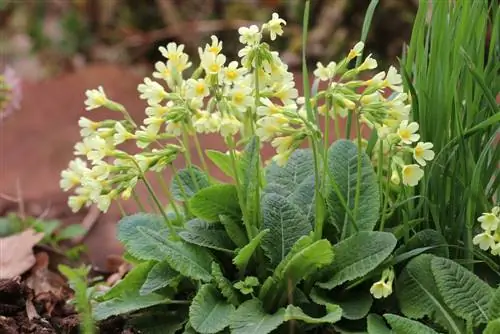
The symptoms are comparable to those in humans, but are often recognized too late. However, for pets or small animals to show symptoms, they must have consumed large quantities.
Danger through intersection
Primroses are popular plants, of which exotic species such as Primula obconica are cultivated as houseplants. Exotics, for example, can trigger an allergy that manifests itself in the form of itching upon contact. Primroses are popular plants for a reason because they are easy to cultivate. It is also easy to create new breeds through crosses. Crossing does not only happen during breeding, but now also between cultivated and wild forms.
The increasing number of cultivated varieties increases the risk that wild forms will cross with cultivated varieties that have a higher content of problematic ingredients. This often results in plants that cannot be clearly identified because they have neither clear characteristics of either the wild form nor the cultivated form. You should therefore refrain from using primroses that cannot be clearly identified.
Sources:
praxistipps.focus.de/primeln-giftig-fuer-mensch-und-haustier-einfach-erklaert_116519
botanikus.de/informatives/giftpflanzen/alle-giftpflanzen/becher-primel/
hundeinfoportal.de/hundewissen/hundegesundheit/vergiftungen-hund/fuer-hunde-giftige-anlagen/
www.katzen-leben.de/katzen-pflanzen/sind-primeln-fuer-katzen-giftig/
de.wikipedia.org/wiki/Echte_Schl%C3%BCsselblume

